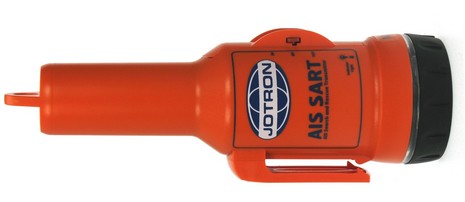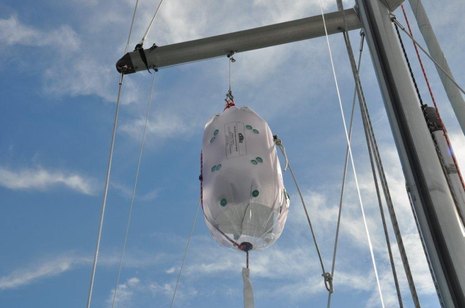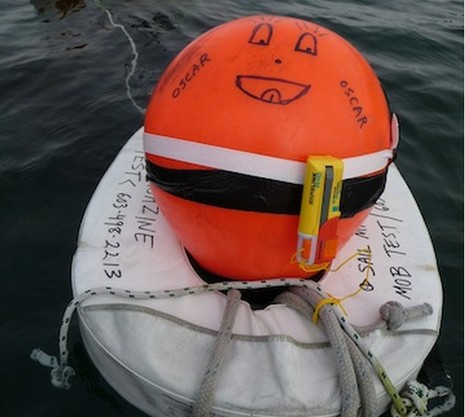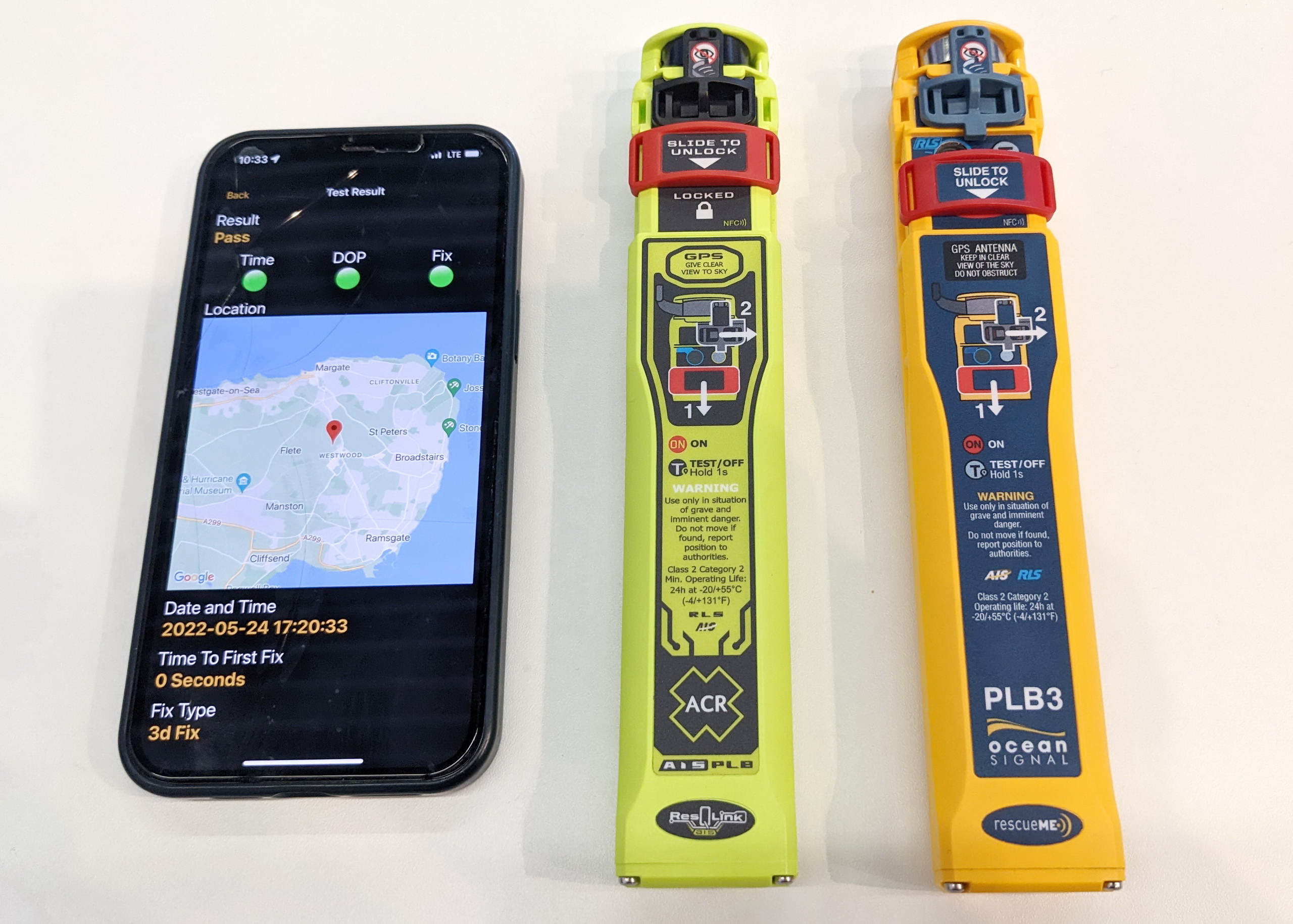Jotron AIS SART, & the L-3 Protec
I once heard a gentleman who probably knew what he was talking about complain fairly bitterly about the electronic radar reflectors called SARTs. He said they’d been pushed on the GMDSS by a member nation where they were made and that they’d never proven themselves effective in search and rescue operations. Which is just one reason why the new Jotron AIS SART is an interesting development…
I found the most detail about this first AIS SART at a GMDSS forum. There you can learn that it’s cleverly programmed to repeat its 1 watt signal 8 times in a 14 second period, and thus hopefully from a wave top at some point, before resting long enough to preserve its battery power for at least 96 hours. In tests it’s been seen from a vessel at up to 10 nautical miles, from a helicopter up to 40, and from an plane up to 132. And it’s only 10 inches tall (though it does cost $1,200). The SART signal should be seen on any AIS plotter where its unusual factory-programmed MMSI is supposed to trigger a special icon. I imagine that the icon will take a while to proliferate via software updates but if bridge teams learn that an MMSI beginning with 970 is a SART, that should help make them effective.
Meanwhile I noticed on the FCC site that the L3 Protec AtoN AIS is now approved and apparently ready to deploy on aids to navigation around the U.S. (pdf brochure here). It can do all sorts of things besides transmitting its position and even weather sensor data to passing vessels. For instance, it can send AtoN health and local AIS info to the authorities ashore. And it can amplify and repeat AIS SART signals! It’s pretty stunning how the uses of AIS are multiplying, and how much confidence international bodies like the IMO seem to have in the technology (and our ability to handle lots of it). And, while those bodies may have missed the mark with the original SART, they have some major successes with EPIRBs, PLBs, AIS, and maybe DSC. The gCaptain likes to think about where this is all headed too.















This was the same AIS device (although in an EPIRB housing) that was detected by Orbcomm satellite during tests In Hawaii last January:
http://www.maritimesafetynews.com/?p=176
More good news: IEC has just published the certification standard for this AIS-SART (IEC 61097-14).
DSC location services have not yet been implemented in Halifax NS Canadian Coast Guard software.
The message below on the Nonsuch Owners site got my attention.
I think this would be an issue worth checking out in other areas of Canada as well as the USA.
John Foster
Marine tech support
——————————–
Last evening I had a tour of the Canadian Coast Guard traffic centre here in Halifax, Nova Scotia. I was simply amazed at the technology and capabilities of the centre except for one thing. Apparently, when I push the red distress button on my radio they receive the DSC call but not in it’s entirety. They do receive my MMSI number but they do not receive my location even though my radio is transmitting it. The Coast Guard officers on duty checked their operational manuals and found that DSC location services have not yet been implemented in their software.
I have no idea if this is the case with all Canadian Coast Guard stations but it sure would be worth checking out. Should an emergency arise it does make sense to push the DSC distress button because the MMSI number links to valuable information but a standard Mayday call giving your position would be critical to your getting help.
I think this would be an issue worth checking out in other areas of Canada as well as the USA.
Jamie Morrison
Dexterity II
30U 225
Halifax, Nova Scotia
Notice that I wrote “maybe DSC” in my list of GMDSS successes. It’s taken an awfully long time for our Coast Guard to adopt DSC themselves (called Rescue 21) but it is finally happening. The combination of a working Rescue 21 system, AIS (because it makes skippers more aware of MMSI numbers and DSC), and more integrated VHF radios may lead boaters to truly adopt DSC in much larger numbers. Maybe.
I think the location problem is not unique to the Canadian CG. Anecdotal evidence tells me that the US SAR centers don’t’ receive the locations either.
Over on the Forums, our main French connection (Benoit) let us know about an interesting relative to the Jotron SART. It’s called “easy Rescue” and it’s from WeatherDock in Germany. Called a MOB personal AIS transmitting beacon, it purportedly “transmits an emergency AIS-SART sentence (MOB)which triggers an alarm on all AIS enabled chart plotters / PC�s within range.” Again, I’m dubious that many plotters or PCs are programmed to do this right now, but it certainly seems possible eventually. I see the easyRescue for sale at some European sites for about $400, but I did not see it in the FCC database last week. More info here:
http://www.weatherdock.com/en/easyrescue.php?active=specs
Thanks, Benoit!
Good grief, Michael, I hope you heard wrong about that! But I do believe that my local USCG station in Rockland is now DSC/Rescue21 equipped and I should experiment. In fact, we all should. Here’s a page with group MMSI numbers for various CG districts:
http://www.uscg.mil/Acquisition/rescue21/benefits.asp
It says that “These numbers can be used to send a DSC message directly to a Coast Guard Sector/Group.” Why not call them on a working channel (which will check your DSC ability) and then ask if you can send them a position (not all radios can do this) or if they will position poll your radio (most all DSC radios can do this).
Incidentally, some newer radios are supposed to have a DSC test call function that is automatically answered by those USCG MMSI numbers. But I haven’t found it yet, and I don’t think it involves location.
For lack of a better “main German connection”, here’s my input on the easy Rescue:
I held an engineering sample of this product in my hands late January on the “boot D�sseldorf” fair at the Weatherdock booth. A product like this is urgently missing, at least in Germany where AIS is more widespread and has been for many years, and I commend them for doing it as it allows to locate your own MOB with kit that is already installed on your boat.
The alternative is a 121.5 MHz homing mechanism, either handheld (e.g., ACR Vecta) or fixed install (e.g., Crewfinder RT-202), which is many times as expensive (not possible within my budget), requires a trained operator in the case of the handheld and does not allow other boats in the area to participate in the rescue.
However, in my opinion, it has some serious drawbacks:
– Antenna: When stowed, the antenna is folded most of the way around the edge of the unit. The antenna is aluminum and shaped like window blinds (curved along the width not the length) which gives it a tendency to open but not very strong. The sample I held had gone through a thousand hands and so the antenna had lost most of it’s tendency to open while the real one only ever needs to open once. I am still dubious, though, about it folding open and staying open while attached to a lifejacket in any serious wind and sea. A unit like the ACR Mini B 300 ILS will give you a whip mark across the face if you are not careful when releasing the antenna.
– Position above the water: I was told that one of the German makers of lifejackets (Kadematic) would adapt a vest to take this unit and hold it high above the water. I didn’t look at the vest. Another German lifejacket maker (Secumar) has a model to hold up a 121.5 MHz transmitter beacon which looks impressive so I think that it can be done. The point is that with this type device it *must* be done. Unlike with a typical PLB (121.5 MHz and EPIRB), if the antenna is horizontal at water level, it will be next to useless.
– AIS only: The unit does not additionally provide a 121.5 MHz signal which would significantly help search and rescue by planes or official lifeboats.
Ideally, I would like to see:
– a device for which I can get lifejackets to hold it up
– from a manufacturer with long reputation in this area and impeccable engineering (I have a Weatherdock easySplit that I am happy with but they have never before done anything that is supposed to be waterproof)
– having 121.5 MHz and EPIRB capability alongside AIS, ideally with GPS (but at least 121.5 MHz)
– advanced testing capabilities like the ACR PLB tested here recently
The Jotron AIS SART does not really fit the bill for me as it is too large and expensive to be worn on a person (to be fair, it doesn’t claim to be “personal”). It is really only suited for use in a liferaft or on a disabled vessel in the process of sinking while a “personal” device such as the easy Rescue can be used in these applications as well. Also, it doesn’t have 121.5 homing capability that is reported to be more important than radar (radar will be useless at the last 1/8 of a mile while the position sent as part of a DSC distress call or EPIRB alert should take care of the longer range).
In spring of 2012 I want to start an Atlantic circuit with my family. If no one has a better product by then, I will get the easy Rescue (two or three, actually).
Interestingly, here in Ireland, where they have DSC for over 10 years, they still get virtually no calls to them using DSC. When I call th using a routine dsc call they always are kinda suprised!
In my opinion dsc should have been reserved soley for distress, it was then complicated to support a kind of selective calling system
dave
I still hold out hope for DSC, Dave, but you may be right.
Thanks, Henning; it seems like you’ve thought about this subject a lot. I’m curious what you think of GPS/DSC/VHF handhelds for man overboard duty. They are still bulky, but can set off a loud alarm on the mother boat and on nearby boats, even a charted location on some systems, plus they have more power than these AIS SARTS, and they’re useful for lots of things besides MOB distress. I’m also curious if WeatherDock explained how the easyRescue would set off an alarm. Did they just mean a CPA alarm, which might be shaky for MOB situations (depending on how a boat’s AIS plotter is set up), or are they talking about a special AIS SART alarm that has to be programmed into all the AIS target plotters?
Ben: In fact, I haven’t thought of a handheld DSC VHF for man overboard duty a lot. For years I wondered why no one made a handheld DSC VHF and I have only learned about it through Panbo recently. I asked the Icom sales rep at boot D�sseldorf about any plans for a DSV VHF and was told “none”. So I have a Standard Horizon HX851 down on my shopping list.
So far I have seen these uses for a handheld VHF: take it along in the dinghy if the outboard fails and you’re beginning to drift out to sea, call the mother ship to find out how many rolls I should bring for breakfast and communication in a rescue situation such as from a liferaft. DSC will help with the first two uses.
AIS immediately made sense to me because you can see it on the chartplotter – better even than a 121.5 homing device which only gives direction not distance. I assumed there would be a special icon for this type of target (I have read about plans in Germany to replace navaids with a virtual version based on AIS. The physical buoy is no longer there and an AIS signal is broadcast from a transmitter on shore nearby providing the former location of the buoy. These would have a special icon, too).
I wasn’t told at boot about how alarming is implemented with the easy Rescue (probably because I didn’t ask). I just compared it with a 121.5 homing device which doesn’t have alarming either.
DSC is certainly good at alarming although with widespread use (in Germany), false alarms are commonplace (supposedly they have increased 8-fold because of DSC). I frequently have to cancel (silence) a DSC alarm when we are on the water. But I guess it wouldn’t be a problem to check around if anyone may have fallen overboard while I do it.
The position indicating capability could be a problem, though. I have a Simrad RS52 dual station that is only two years old (it has SimNet so must even have NMEA2000). I heard or read that it doesn’t support “buddy boating” – automatically replying to a DSC position request and sending the sentence with the position of the buddy boat on NMEA0183 or 2000. I don�t know and cannot find out right now if it can output on the bus the position of a DSC distress call. That would be a good thing in any case and I will look into it and consider it when deciding on the PC/Chartplotter solution.
There is also the issue of our two year old daughter who is the most likely crewmember to fall overboard. Even last season at one and a half she climbed up the companionway and out of the cockpit onto the side deck unnoticed on one occasion (though we try to keep her shackled to jack lines). I couldn’t teach her to press the distress key on the HX851 when in the water and hold it for 5 seconds with any reasonable hope of success. Although, come to think of it, that is exactly what I tried to teach her not to do on the cockpit station of the RS52… But then, the easy Rescue must also be manually released by removing a plastic cradle that frees the antenna.
There is no form of SART (search and rescue transponder) function in the easy Rescue.
I stated the incorrect model number for the Simrad DSC VHF. The correct model is RS82. I downloaded the manual and learned:
– the following NMEA0183 sentences are read as *input*: GGA, GLL, RMC, ZDA
– there is no NMEA output whatsoever
– there are 2 SimNet connectors but no mention what data is read from the SimNet (NMEA2000) and what is written. Specifically, there is no mention that any is written at all.
– There is an “iDSC” connector that is referred to as an output and that is physically identical to the NMEA0183 connector. The following information is given for this port:
“12.2.4 iDSC output
The RS81/82 is designed to integrate with other Simrad equipment,
which enables DSC call information to be displayed on
the 33, 42 and 52 series Chartplotters.
Connect the iDSC input terminals of the chartplotter to the terminals
marked �iDSC� as shown (Fig 12.7):”
Maybe I should connect a PC with Hyperterminal to it and find out if there is any NMEA0183 data on it (I will use a RS422 to RS232 coupler with optical protection). This will have to wait until the mast is back on the boat and I find someone to call me on DSC or someone to send a DSC distress call… 😉
Also, I guess I should query Navico Germany about this. This might also take a while as I want to use my special contact but I will post any information here that I might get.
Regarding Jotron Tron AIS-SART:
Please see http://www.jotron.com/admin/images/viewresource.asp?aid=2237 about how to test and appearance on ECS/ECDIS (Chartplotter)
Thanks, Fred. The USCG’s Jorge Arroyo also sent me IEC62288 documentation about what AIS SART and AIS ATON icons will look like on IEC compliant displays. Plus he explained that the “AIS SART signal burst is actually a combination broadcast of an AIS message 14 (Safety related text message stating �SART ACTIVE�, nominally every 4 min.) and an AIS message 1 (Class A Position Report with a nav status = 14 , 8 per minute); both of which should be readable by all existing AIS systems.”
Which is all well and good, but, geez, there are a lot of AIS transponders and target plotting programs today that still haven’t been updated to understand the Class B Static Data message that was written at least four years ago (I think). Plus I’m not sure how many recreational AIS displays can show Safety Related Messages, or what any will do with Navigation Status #14, which is currently listed as “reserved”.
I suspect that it will be a while before many vessels will see an AIS SART as anything more than an unknown target. But that’s way better than nothing, of course, and in most real world situations vessels and SAR folks will be looking for the target because the distress was broadcast in other ways.
Yes, you’re right Ben. It will take some years before all AIS receiver, AIS transponders, Chartplotters etc will be upgraded to see AIS-SART as the AToN symbol:
(Tried to insert picture in the comment, but it is not supported, link to symbol here: http://baatplassen.no/img/3/3129/aissart.png ) But it seems that at least in Norway, the JRCC service is receiving the signals through the chains of AIS Base stations and may announce information to ships in this area to assist if necessary. And the text message “SART ACTIVE” that is sent every 4 minutes also helps users of “Old AIS transponders/receivers” to be aware of that something is going on in their area. I know that the Norwegian ECS/ECDIS supplier, Telko (Tecdis/Telchart) already have implemented the new AIS-SART symbols in their maps
My link to the AIS AtoN symbol above doesn’t work. Maybe it is not allowed to link from this page.
Your link works for me, Fred, but I think the AIS SART icon, which is different than the AIS AtoN icon, should be a red circle with an “X” inside it. According to IEC62288, it should be 5mm in diameter, use a “thick dashed line style” and “shall flash until acknowledged by the user.” That should get attention once enabled on AIS plotting screens!
Hi Ben, do you have a different version of IEC62288 than me? IEC62288 ed.1.0 (2008-07)
Mine says:
2.11 AIS search and rescue transmitter
An AIS search and rescue transmitter (AISSART)
shall be drawn with a solid line and
shall be the same basic colour as the AIS
ATON symbols.
while SN/Circ.243, Add 1 says:
AIS Search and Rescue Transmitter
(AIS-SART):
A circle containing a cross drawn with
solid lines
Correct link to AIS-SART symbol
Thanks, Fred. The red icon in that second link is the same AIS-SART icon I’m looking at. But the AIS ATON icom seems quite different. Here’s the description:
“AIS Aids to navigation (ATON) shall be
presented as a diamond with crossed lines
centred at the reported position of the ATON.
The crossed lines shall not be more than 2
millimetres in length. For a virtual AIS ATON,
the sides of the diamond shall be not more
than 6 millimetres in length. For a real AIS
ATON that is on position, the diamond shall
encompass both the charted ATON symbol
and the reported position of the ATON. For a
real AIS ATON that is off position, the
diamond shall be drawn as for a virtual AIS
ATON apart from the charted symbol. The
diamond and crossed lines shall be drawn
using a thin solid line style. Recommended
colour for an �on position� AIS ATON: blue.
Recommended colour for an �off position�
AIS ATON: red.”
I just e-mailed you the material I have thanks to the good Mr. Arroyo.
JOTRON and McMurdo AIS-SARTs are FCC/ USCG approved:
https://fjallfoss.fcc.gov/oetcf/eas/reports/GenericSearch.cfm
Search for:
1) Equipment Class = AIS
AND
2) Frequency Range in MHz = “161.975” to “162.025”